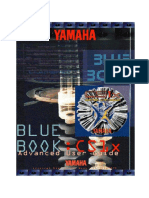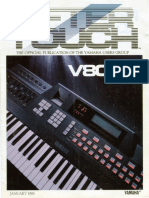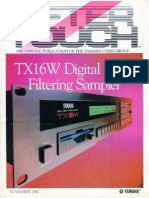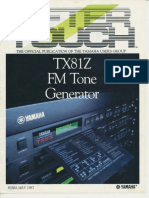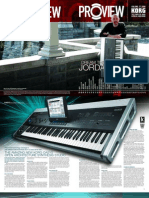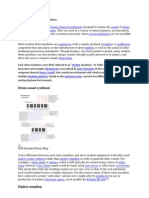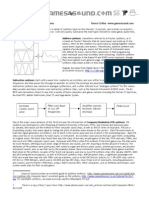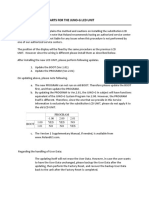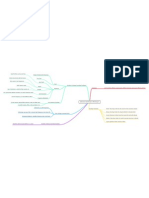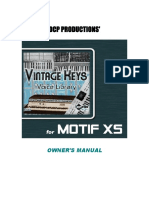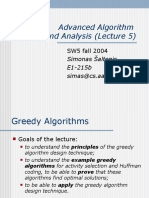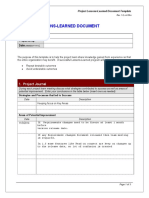AfterTouch 1987 06
AfterTouch 1987 06
Uploaded by
SteveDFCopyright:
Available Formats
AfterTouch 1987 06
AfterTouch 1987 06
Uploaded by
SteveDFOriginal Title
Copyright
Available Formats
Share this document
Did you find this document useful?
Is this content inappropriate?
Copyright:
Available Formats
AfterTouch 1987 06
AfterTouch 1987 06
Uploaded by
SteveDFCopyright:
Available Formats
-
-
-
-
-
- -
- - -
-
- -
- --
-
-
-
-
-
-
-
-
THE OFFICIAL PUBLICATION OF THE YAMAHA USERS GROUP
JUNE 1987
8YAMAHA
Editor
Tom Darter
Operations
Sibyl Darter
Editorial Board
Bob Frye
Bill Hinely
Mark Koenig
Jim Smerdel
Cover Photograph
Jim Hagopian
AITERTOUCH is pub-
lished monthly. Third class
postage paid at Long
Prairie, MN and additional
points of entry.
SUBSCRIPTIONS: Free.
Address subscription cor-
respondence to AITER-
TOUCH, P.O. Box 2338,
Northridge, CA 91323-
2338. POSTMASTER:
Send form 3579 to P.O.
Box 2338, Northridge, CA
91323-2338.
- -
- -
- -
- -
- -
- -
-
-
-
-
-
-
-
-
--
-
-
-
-
-
-
-
June 1987 Volume 3, Number 6
Issue #21
4 Micro Tuning
Exploring the Micro Tuning capabilities on the DX7 II. By
Howard Sandroff.
6 WX7 Sound Sheet
An introduction to the enclosed Evatone Sound Sheet,
ing Yamaha's new MIDI wind controller. By Tom Darter.
7 RICKNGRETCH
A new DX7 voice created by Chris Corso.
8 STEPORGAN
A new DX7 voice created by Bruno Choiniere.
9 CATHEDRAL
A new DX7 voice created by Barry Carson.
10 SOFT STEEL
11 TX802
14 RX5
15 RX5
A new DX7 voice created by Bryan Pape.
A first look at Yamaha's new FM digital tone
generator. By Tom Darter.
"RXS Gated Snare" and "Sonar Reflection," two new RXS
voice edits created by Vincent Bitetti.
"Meteorite" and "TrainThruTunnel," two new RXS voice edits
created by Vincent Bitetti.
1987 Yamaha Music Corporation USA. No pare of this publication may be reproduced, stored in a retrieval system, or transmitted in any form or by any means,
electronically, mechanically, photocopying, recording, or otherwise, without the prior written permission of Yamaha International Corporation.
2 AITERTOUCH!Vol. 3 No. 6
From The Editor
O
NCE AGAIN, I want to use this column
to pass along some standard information
that continues to be important for AfterTouch
readers. Before we get to that, however, let's
start with a quick look at what you can expect
to find in this issue and the next issue:
This Month: This issue features the return of
the Evatone Sound Sheet. Our first set of
Evatone Disks appeared in the May, June, and
July 1986 issues of AfterTouch. This month,
our Sound Sheet will introduce you to Yamaha's
exciting new WX7 MIDI Wind Controller, fea-
turing compositions and performances by Sal
Gallina, a top New York studio musician. The
Sound Sheet is bound between pages 6 and 7 of
the issue-give it a listen!
In addition, there is an introduction to
Yamaha's new 6-operator FM digital tone gener-
ator, the TX802. You will also find a set of
edited RXS voices, new reader DX7 patches,
and an article that discusses the basics of the
Micro Tuning capabilities found in the new
generation of DX7 instruments (DX7 II FD,
DX7 II D, DX7s, and TX802).
Next Month: In July, we are going to devote
almost the entire issue to material from readers!
Most importantly, two popular columns will
return (after an extended, six-month holiday):
the Questions column, in which we answer que-
ries from readers, and the Final Touch column,
in which we feature hot tips from readers. There
will also be an article that describes some inter-
esting musical uses of the MEP4 MIDI Event
Processor, plus reader patches, and more. See
you then.
Receive AfterTouch Free Every Month!
Back Issues: If a request for back issues is
combined with a subscription request or other
material, chances are it will not be fulfilled. All
requests for AfterTouch subscriptions must go
to our Mailing List input service. After the
addresses are entered, the letters are normally
kept on file, in keeping with various postal
regulations. To be absolutely sure that you
receive any available back issues that you want,
make back issue requests separately, and include
the indication "ATTN: Back Issues" on the en-
velope. Please do not send back issue requests
on the attached subscription postcard.
Warranty Cards & AfterTouch: We have
received a number of letters from Yamaha users
complaining that they expected an AfterTouch
subscription because they recently purchased a
Yamaha product and sent in a warranty card,
but still haven't received an issue. It is true that
our initial (1985) mailing was developed from a
warranty card list, but no subscriptions were
sent to those names-just a sample mailing of
the first three issues. In order to receive a free
subscription, you need to send us your request
on the attached postcard below.
Product Literature: All requests for specific
product literature must go directly to Yamaha
(Yamaha Music Corporation USA, P.O. Box
6600, Buena Park, CA 90622). We at
AfterTouch are happy to receive specific ques-
tions concerning the use of Yamaha professional
music products, and we will answer as many of
them as we can in the Questions column; how-
ever, requests for general product information
must be sent directly to Yamaha.
-TD
Y
OU CAN RECEIVE AFTERTOUCH for an entire year, absolutely free, just by
asking. If you are not already on our mailing list and would like to be, fill out the
attached postcard. Be sure to sign the card (a postal regulation); it lets us know that
you really want to receive AfterTouch.
After you have filled in the relevant information, put a stamp on the postcard
and mail it to us. When we receive the card, we'll put you on our permanent mail-
ing list, and you will receive twelve issues of AfterTouch absolutely free! There is
absolutely no obligation, and no other strings are attached.
(By the way, if you received this issue in the mail, you are already on our perma-
nent mailing list, so you don't need to send in another card.)
Also, don't limit yourself to just sending in your address: Let us know what you
want to read, and what you have to offer (see page 19 for details). We look forward
to your input.
TOUCH is a
monthly
informational
publication from
Yamaha
To receive
TOUCH every
month,
lutely free, just
put your name
and address on
the enclosed
card and mail it
to us.
Vol. 3 No. 6/ AFTERTOUCH 3
Micro Tuning
4
Exploring The
Micro Tuning
Capabilities Of
The DX7 II
FD/D.By
Howard
Sandroff.
DX7 II FD digital FM
synthesizer.
On The DX7 II FD/D
Each of these tables gives the addition, the deviation of each
Micro Tuning data found in note from equal temperament
the Edit mode LCD displays in cents is indicated in the col-
for the octave C3-C4, includ- umn labelled ' '.6.ET. ' ' The
ing the note name, coarse and size of the interval between
fine tune values, and the consecutive notes is also indi-
Micro Tuning data for Preset number of tuning units (TU) . cated in tuning units (TU)
THE CURRENT GENERATION of
#I: Equal Temperament. used to represent each note. In and cents.
Yamaha 6-operator synthesizers and tone
Note Coarse Fine Tuning L\ET Interval Size
generators (DX7 II FD, DX7 II D, DX7s, and
Name Tune Tune Units Cents TU Cents
TX802) gives electronic musicians a number of
>>> c 3 <<< c 3 +0 5034) +0.00
expanded possibilities for the creation of new
86 100.78
timbres. However, the Micro Tuning options
>>> C#3 <<< C# 3 +0 5120) +0.00 open up other universes that offer even greater
85 99.61 potential for the exploration of new harmonies
>>> D 3 <<< D 3 +0 5205) +0.00
and melodies.
85 99.61
>>> D#3 <<< D#3 +0 5290) +0.00
hu 100.78
The DX7 II Micro Tuning Presets
>>> E 3 <<< E 3 +0 5376) +0.00
The DX7 II contains eleven preset Micro
85 99.61
>>> F 3 <<< F 3 +0 5461) +0.00
Tunings. These can be divided into two groups.
85 99.61
There are nine diatonic tunings, as follows:
>>> F#3 <<< F# 3 +0 ( 5546) +0.00
1) Equal Temperament
86 100.78
2) Pure (Major)
>>> G 3 <<< G 3 +0 5632) +0.00
3) Pure (Minor)
85 99.61
>>> G#3 <<< G# 3 +0 ( 5717) +0.00
4) Mean Tone
85 99.61
5) Pythagorean
>>>A 3 <<< A 3 +0 5802) +0.00
6) Werckmeister
86 100.78
7) Kirnberger
>>> A#3 <<< A# 3 +0 5888) +0.00
8) Vallotti & Young
85 99.61 9)
1
/4 Shifted Equal
>>> B 3 <<< B 3 +0 5973) +0.00
Of these nine diatonic tunings, five (presets
85 99.61
>>> c 4 <<< c 4 +0 6058) +0.00
#1, #6, #7, #8, and #9) are "closed" tunings,
...___
AITERTOUCH/Vol. 3 No. 6
-------- ---- --- ~ ~ ~ -- ----------
7 Sound Sheet
An lntroduc ..
tion To The
Attached
Evatone Sound
Sheet, Featur ..
ing Yamaha's
NewMIDI .
Wind Control ..
ler. By Tom
Darter.
WX7 MIDI wind controller.
T
HIS ISSUE FEATURES the return of the
Evatone Sound Sheet. Our first set of
Evatone Disks appeared in the May, June, and
July 1986 issues of AfterTouch. This month,
the Sound Sheet is a musical introduction to
Yamaha's exciting new WX7 MIDI Wind
Controller, featuring compositions and perfor-
mances by Sal Gallina. Sal is a top New York
studio musician who has worked with a number
of artists on such labels as RCA, CBS, Poly-
gram, Arista, and Capitol.
Side 1 of the Sound Sheet displays the
expressive power of the WX7 in a series of solo
voice performances. Except where noted, the
tone generator used was a TX81 Z.
1) E. Guitar
2) Power 01
3) Violin
4) Flute 01
5) A. Guitar
6) Clarinet
7) A. Bass 01 (DX7 II)
8) E. Bass 01 (DX7 ll)
9) Sax 01
10) Strings
Side 2 of the Sound Sheet features two Sal
Gallina compositions, "Rock 1" and "Orches-
tral!."
"Rock 1" was created in the studio with tape
overdubs. On the first pass, the drum part (gen-
erated by an RXS) was recorded, along with the
"rhythm guitar" part. Actually, the rhythm gui-
tar part is the WX7 controlling a TX81Z with
the "Power 01" patch. On the second pass, Sal
added the "bass," which was again the WX7,
6 AFrERTOUCH/Vol. 3 No. 6
this time controlling a DX7 II with the "E. Bass
02" patch. On the third and final pass, Sal re-
corded the "lead guitar"-WX7 controlling a
TX81Z with the "E. Guitar" patch.
"Orchestral!" was created in real time, with
no overdubs. Sal used various Strings voicings
on the TX81Z, with pitch shifts and other
effects used to create complex voicings. In addi-
tion, he made use of the WX7's "sustain" fea-
ture: To begin with, 4 string voices were as-
signed to MIDI channel 1, and the other 4 were
assigned to MIDI channel 2. Sal began by play-
ing on channel 2, and then engaged the "sus-
tain." While the notes on MIDI channel 2 were
sustaining, he switched to MIDI channel 1 and
played the other 4 string voices in real time.
Both an SPX90 and a REV7 were used
throughout the recording-the REV7 for reverb,
and the SPX90 for delay, flanging, pitch shift,
and other signal processing effects.
For those who are interested in more infor-
mation on the WX7, Sal Gallina has written a
book: Expressive FM Applications. The book
is being published by the Yamaha Music
Foundation, and will be included with your
WX7. It will also be available in the fall at your
local book store or Yamaha music dealer. The
86-page book will come complete with a dem-
onstration cassette (which will be new material,
not a duplicate of the Sound Sheet in this is-
sue), as well as complete voice data and special
effects setups for all the material on the cas-
sette. In all, there will be data for 32 TX81Z
voices and 32 DX7 II voices.
0 0 0 OFF 3
DELAY FMD SYNC PMB
AI A2 A3
"" 99 99 99 99
Ll 1.2 L3
L(
50 50 50 50
KEY TRANSPOSE
06C.SYNC
I POLY I 2 J 0 OFF I OFF I 0 I
POlY.woNOI 1WI<lE STEP
PITCH BEND POATAM&ITO
RANGE PITCH AMPLITUDE EGBIAS
MODWHEB. 0 OFF OFF OFF
FOOT CONTROl
0 OFF OFF OFF
-THCONTAOl 0 OFF OFF OFF
0 OFF OFF OFF
FAEOJENCY I DETIJoiE
7.00 +1
lAMS 0
FAEIJUENCY I DETLNE
15.00 +1
lAMS 0
ENVEl.OPE !lilT A eNELOPE !lilT A
AI IA2 I"' I"" IRS IA2 I"' I"" IRS
53 34 27 39 4 78 48 38 31 3
Ll IL2 11.3 IL( I Ll IL2 11.3 IL( I
99 81 0 0 99 85 0 0
KEYIIOAAD SCN.HCl KEYIIOAAD SCN.HCl
C:UAVE BAEAKPOM" DEPTH CUAIIE BAEAKPONT DEP1H
L I -E I I L I 0 L l -E J I L I 0
C1 C1
R I +E I I R I 21 R I +E I I R I 0
OPt
I DUTPUT LEVB. I VELOCITY . OPt I OUTI'UT LEVEL I VELOCITY
5 57 4 8 88 1
I
'
t
FAEOOENCY I OETLNE
8.00 0
lAMS 0
FAEIJUENCY I OETLNE
1.00 -1
lAMS 0
9NB.OPE DIITA eNELOPE !lilT A
AI IA2 !"' l"' !Ill AI IA2 I"' I"" IRS
99 78 31 40 7 55 89 10 47 5
Ll 11.2 11.3 IL( I Ll IL2 t"' IL( I
7
99 99 0 0 49 97 0 0
KEYBOARD SCN.HCl KEYBOARD SCALING
CURVE BREAKPOINT DEPTH CURVE BAEAI<PONT DEP1H
L I -E I Cf I L I 0
L I -E I .I L I 0
Al1
R I +E I I R I 0 R I +E I I R I 41
OPt
I OUTPUTLEVB. I VELOCITY
OPt
l DUTPUT LEVB. I VELOCITY
2 78 0 4 91 1
J
FAEaJENCY I DElUIE I AMS
8.00 +7 0
FAEIJUENCY l DE1UIE
1.00 0
lAMS 0
eNB.OPEDIITA eNELOPEDIITA
AI IA2 1113 t 1111 AI IA2 I"' I"" IRS
50 78 58 40 7 80 14 13 40 7
Ll IL2 11.3 IL( I L1 ILZ 11.3 IL( I
0 99 0 0 99 91 0 0
KEYBOARD SCN.HCl KEYIIOAAD SCALING
CURVE BAEAJ<POINT DEP1H CUAIIE BAEAI<PONT DEPTH
L I -E I I L I 0 L I -E I I L I 0
C1 C1
R I +E I I R J 0 R I +E I I R I 0
OFI
I OUTPUT LEVEL I VELOCITY
OPt
I OUTPUTLEVEL I VB.OCITY
1 99 8 3 99 3
I
I
ALGORITHM 115
DX7
RICKN ..
GRETCH.
ANewDX7
Voice By
Chris Corso.
Notes:
This is a "Pink Floyd" type of
guitar sound.
Vol. 3 No. 6/ AFTERTOUCH 7
B
R
J
N
C
T
I
O
N
S
.
-
-
P
O
L
Y
I
1
I
0
I
O
F
F
I
O
F
F
I
0
I
P
O
L
Y
I
M
O
N
o
f
R
A
N
G
E
S
T
E
P
M
O
D
E
G
L
I
S
S
A
N
D
O
T
I
M
E
P
I
T
Q
-
I
B
E
N
D
F
O
R
T
N
o
E
N
T
O
I
I
D
!
v
I
!
I
!
I
!
:
I
!
l
R
A
N
G
E
P
I
T
C
H
A
M
P
U
T
U
D
E
E
G
B
I
A
S
R
1
9
9
L
1
9
9
C
U
R
V
E
L
R
O
P
t
1
\
z
Q
)
p
:
:
.
.
.
.
,
.
.
A
S
0
D
E
P
T
H
0
0
[
U
M
O
D
\
\
t
i
E
E
I
.
9
9
O
N
O
F
F
O
F
F
R
l
O
T
C
X
l
N
T
R
a
.
0
O
F
F
O
F
F
O
F
F
K
E
Y
T
I
I
N
I
S
P
O
S
E
O
S
C
.
S
Y
N
C
B
R
E
A
l H
C
O
N
T
A
O
I
.
0
O
F
F
O
F
F
O
F
F
A
F
T
E
I
!
T
a
J
C
H
0
O
F
F
O
F
F
O
F
F
P
I
T
C
H
E
N
V
E
I
.
O
P
E
F
R
E
I
1
J
E
N
C
Y
I
o
e
r
u
;
,
E
1
.
-
o
F
R
E
Q
U
E
N
C
Y
I
o
e
r
u
;
,
E
1
.
-
o
F
I
I
B
l
l
J
e
j
(
;
y
1
.
-
o
2
.
0
0
3
.
0
0
4
.
0
0
E
N
V
E
l .
O
P
E
E
N
V
B
.
O
P
E
E
N
V
a
.
O
P
E
R
1
I
A
2
I
"
'
I
A
4
I
R
S
R
1
I
A
2
I
"
'
l
i
M
I
R
S
R
1
T
A
2
T
R
I
I
A
4
A
S
R
1
2
9
9
9
9
9
9
9
0
2
3
9
9
9
9
9
9
0
1
9
9
9
9
9
9
9
0
1
6
L
1
I
L
2
1
1
3
I
I
A
I
L
1
I
L
2
1
1
3
I
I
A
l
L
1
l
l
2
T
l
3
T
I
A
L
1
4
7
9
9
9
9
0
4
7
9
9
9
9
0
4
7
9
9
9
9
0
4
7
K
E
Y
B
O
A
R
D
S
C
A
L
J
I
G
K
E
Y
B
O
A
A
D
S
C
A
L
H
G
K
E
Y
B
O
A
R
D
S
C
A
L
I
I
G
C
U
R
V
E
B
A
E
A
K
P
O
M
D
E
P
T
H
C
U
R
V
E
B
R
E
A
K
P
O
N
T
D
E
P
T
H
C
U
R
V
E
B
A
E
A
K
P
O
M
D
E
P
T
H
C
U
R
V
E
L
I
-
L
I
I
L
I
0
L
I
-
L
I
I
L
T
0
L
T
-
L
T
I
L
0
L
A
-
1
A
-
1
r
T
R
1
-
L
1
A
-
1
r
R
R
I
-
L
I
I
R
I
0
R
I
-
L
I
R
0
0
R
O
P
t
I
O
U
T
P
U
T
L
E
V
E
L
I
V
E
L
O
C
n
Y
O
P
t
I
O
U
T
P
U
T
L
E
V
a
.
I
v
a
.
o
c
n
v
O
P
t
I
O
U
T
P
U
T
L
E
V
E
L
I
V
E
L
O
C
n
Y
O
P
t
2
9
9
0
3
9
9
0
4
9
9
0
5
I
I
I
-
-
-
A
L
G
O
R
I
T
H
M
1
3
2
A
S
0
D
E
P
l
H
0
0
"
'
6
z
"
'
i
u
5
t
<
c
o
0
....
Cl> 0
Cl>
..,
i! :s
Cl> 0
Cl>
..,
12 !l
Cl> 0
Cl>
..,
II! !:l
Cl> 0
Cl>
..,
1i :::;
It z t:: t::
ffi 0 0 0 0
I
!!! u.. u.. u.. u..
u.. u.. u.. u..
0 0 0 0
--------------
::li
::t
!::
a:
0
Cl
...I
""
DX7
CATHEDRAL.
ANewDX7
Voice By
Barry Carson.
Notes:
This patch recreates the sound
of a cathedral pipe organ. A
pipe organ swell pedal
increases the volume of the
instrument not simply by
making the organ sound
louder, but by adding ranks of
pipes to the existing sound.
This is what the modulation
foot controller does in this
patch: With the controller in
the off position, a soft organ
sound at 16' and 8' is heard;
as the pedal is depressed, other
ranks of pipes are brought in.
The footo.ges of these pipes can
be changed by changing the
Frequency Coarse settings of
the various operators.
Vol. 3 No. 6/ AFTERTOUCH 9
DX7
SOFT STEEL.
ANewDX7
Voice By
Bryan Pape.
These DX7
voices can also
be loaded into
all the other
Yamaha 6,oper,
ator FM digital
synthesizers and
tone generators,
including the
DXS, TX7,
TX216, TX816,
TFl, DXl
DX7s, TX802,
and DX7 II
FD/0.
10 AITERTOUCH!Vol. 3 No.6
COOTROU.ERl RANGE
MOO WHEEL 99
FOOT COOTROL
0
BREATH COOTROL 0
AFTEAltlUOi 0
0
[EiJ
KEYTIWISPOBE
~
06C.S'INC
PITQi AMPLITUDE EGBIAS
OFF ON OFF
OFF OFF OFF
OFF OFF OFF
OFF OFF OFF
t
FREQJe:Y JIJElUIE J ~ M S
FRBlUe:Y
J ~ J-1
0.50 0 1 1.00
ENVEI.OPEMTA ENVELOPE MTA
R1 IR2 IRI IFM IRS R1 IR2 IRI IFM JRS
95 28 27 43 0 95 28 27 43 0
Ll IL2 11.1 11.4 I Ll r 11.1 11.4 1
999999 0 99 99 50 0
KEVIIOAADSCALIa KEVIIOAADilCALJIQ
CURVE BREAKPOM' DEI'IH CII'IIIE BREAKPOM' DEPTH
L I L I I L I 0 L I L I I L I 0
A1 A1
R I L I I R I 0 R JL l l R l 0
01'11
I OUTPUT LEVEL I VELOCilY
01'11
J OUTPUT LEVEL J VELOCITY
3 92 ' 3 6 99 0
~ J
FREQJe:Y IIJElUIE 1-
0.50 0 1
FRBlUe:Y IIJElUIE
1.00 0
1-1
ENVELOPEMTA ENVEI.OPE MTA
R1 1"" t IFM IRS R1 1R2 lRI IFM IRS
88 92 71 43 0 83 0 27 43 0
Ll IL2 11.1 11.4 I Ll IL2 11.1 11.4 I
99 99 90 90 99 99 0 0
KEVIIOIIAD llCALJIQ KEYIIOARO llCALJIQ 1
CII'IIIE BREAKPOINT DEPTH Cl.fiiiE BREAKPOIOT DEPlH
L I L I I L I 0 L I L I I L I 0
A1 A1
R I L I I R I 0 R I L l l R l 0
01'8
I OUTPUT LEVEL l VEI.OCnY
01'11
l OUTPUT LEVEL rELOCilY
2 90 1 5 88 3
J J
FREQJe:Y lllElUIE
0.50 0
1-1
FRBlUe:Y lllElUIE
1.00 0
J-1
BWELOPEMTA ENVEI.OPE MTA
R1 IR2 IRI IFM IRS R1 IR2 IRI IFM IRS
99 0 0 43 0 88 28 27 43 0
Ll IL2 11.1 11.4 I
Ll l
2
11.1 t l
99 99 0 0 99 99 99 0
KEVIIOIIAD SCALING KEYBOARD SCALING
CII'IIIE BREAKPOINT DEPlH CII'IIIE BREAKPOIOT DEPlH
L I L I I L I 0 L I L I l L l 0
A-1
A-1 I I
R I L I I R I 0 R I L I R 0
CPO
I OUTPUT LEVEl. I VELOCnY
01'11
1
OUTPUT LEVEl. rELOCITY
1 99 4 4 99 4
I I
ALGORITHM #4
Y
AMAHA HAS TAKEN the expanded
technology of its growing family of second-
generation DX7 digital FM synthesizers and
packaged it in a new rack-mount FM digital
tone generator-the TX802. Like the other
members of this new generation, the DX7 II
FD, DX7 II D, and DX7s, the TX802 uses the
industry standard DX7 6-operator, 32-algo-
rithm voice as its starting point; but, also like its
older brothers, it offers a number of important
new features.
Like all members of the new 6-operator gen-
eration, the TX802 has a faster DAC (Digital-
to-Analog converter) and a more powerful
CPU (Central Processing Unit). The higher
resolution and faster computation provided by
these new components gives the TX802 a
cleaner, clearer, warmer sound. Any patch cre-
ated on a first generation 6-operator instrument
will sound better when transferred to the
TX802.
The TX802 also bears a kinship with
Yamaha's other recent FM tone generators, the
FB-01 and TX81Z, in that it is multi-timbral.
The TX802 has the same 16-note capacity of
the DX7 II, but these 16 notes are created by
eight independent tone generators; therefore,
the TX802 can play up to eight different
timbres at the same time. In the TX802's exten-
sive Performance mode, each timbre can be
assigned its own MIDI channel, note range,
and number of notes (in multiples of two).
Memory
The TX802 features a memory that is much
expanded over that of the first generation of 6-
operator synthesizers and tone generators. First
of all, it comes with 128 factory preset voices,
which are a permanent part of the instrument's
Read-Only Memory (ROM). In addition, the
Internal memory has capacity for 64 user-
programmable voices. Beyond this, an addi-
tional 64 voices can be accessed from a RAM4
cartridge via the cartridge port on the instru-
ment's front panel. As many as 256 voices can
be available for use at any one time.
In addition to the 64 Voice memories, the
TX802's Internal memory has capacity for 64
Performance memories, 2 user-defined Micro
Tuning memories, and an extensive System
Setup memory.
TX802
The TX802 features a 40 X 2 backlit LCD
and an easy-to-use front panel. The eight Mode
Select buttons call up a number of different op-
erations. The Performance Select and Voice
Select buttons allow you to call up a Perfor-
mance or a Voice for playing or editing. The
System Setup, Utility, Performance Edit, Voice
Edit (I), and Voice Edit (II) buttons each call
up a menu with eight items, which are selected
using the eight Parameter Select buttons situ-
ated under the LCD. The function of the Store/
Compare button depends on the situation. On
the TX802, both the Performance Edit mode
and the Voice Edit mode offer Edit/Compare
(unlike the DX7 II, which only allows Edit/
Compare in Voice Edit mode).
Performance Select Mode
As mentioned above, the TX802 contains
eight independent tone generators, each of
which produces two notes. Each tone generator
has its own rear-panel audio output. Each tone
generator can be set to a different voice and
MIDI channel, and can be played as an inde-
pendent instrument with 2-note polyphony. It is
also possible to link several tone generators
together to form an instrument with 4-note to
6 ~ n o t e polyphony.
A combination of settings for these eight
tone generators is called a Performance. There
are 64 Performance memories in the TX802,
and an additional 64 Performance memories
can be stored (for immediate access) on a
RAM4 cartridge. These settings are created-or
altered-in Performance Edit mode.
Performance Edit Mode
When you call up the Performance Edit
menu, you have access to these eight items:
1) Receive Channel, Alternate Assign,
Forced Damp
2) Volume
3) Output Assign
4) Low/High Note Limit
5) MIDI Note Shift
6) Micro Tune Scale Select and Key Select
7) Performance Detune
8) Performance Name
Each one of these parameters can be set in-
dependently for each one of the eight tone gen-
A First Look At
Yamaha's New
6 .. 0perator FM
Digital Tone
Generator. By
Tom Darter.
Vol. 3 No. 6/ AFTER TOUCH 11
TX802 Continued
This chart shows the param-
eters that can be programmed
in the TX802's Performance
Edit mode.
Tone Generators 1
I
Voice number
Channel
Forced Damp
Volume
Output Assign
Low Limit
High Limit
Note Shift
Micro Tuning Scale
Micro Tuning Key
Detune
Performance Name
erators in the TX802. (See the accompanying
diagram.)
System Setup Mode
This is where you make various settings
(MIDI and otherwise) for the TX802 itself.
When you call up the System Setup menu, you
have access to the following items:
1) MIDI Receive
2) MIDI Control Number Assign
3) Performance Select (MIDI Program
Change)
4) MIDI System Exclusive
5) Cartridge Bank Select
6) Micro Tuning Edit
7) Master Tuning
8) Internal Memory Protect
"MIDI Receive" allows you to specify how
five types of incoming MIDI data will be
received.
"MIDI Control Number Assign" allows you
to program the Control Number Table, and lets
you re-assign incoming MIDI Controller mes-
sages. Any incoming control number (0-31 and
64-127) can be assigned to any of the following
functions:
off
Modulation Wheel
Breath Control
Foot Control
Portamento Time
Volume
Sustain Switch
Portamento Switch
"Performance Select" is where you deter-
mine how Performance memories will be
selected by incoming MIDI Program Change
messages.
12 AFfERTOUCH/Vol. 3 No.6
2
I
3
I
4
I
5
l
6
I
7
I
8
Banks I, C. A, B 1-64
1-16, omni
on/off
0-99
off. I, II, I+ II
C-2- G8
C-2 - G8
-24- +24
p 1-11, 11-2, c 1-63
C-B
-7- +7
20 characters
All of the settings created in System Setup
Edit mode (with one exception) are saved as
part of the System Setup memory. The excep-
tion is Micro Tuning-any user-created Micro
Tuning must be stored in Micro Tuning memo-
ries 1 or 2 (or on a RAM cartridge formatted for
Micro Tunings), because the Micro Tuning Edit
Buffer is not part of the System Setup memory.
Utility Mode
The Utility mode contains a number of
important MIDI, cartridge, and initializing
functions. When you call up the Utility menu,
you have access to the following items:
1) MIDI Transmit
2) Save to Cartridge
3) Load from Cartridge
4) Format Cartridge
5) Initialize Edit Buffer
6) Initialize Control Number Table
7) Recall Edit Buffer
8) Copy
If you call up MIDI Transmit (Utility menu
item # 1), you have the choice of any of the fol-
lowing data, for transmission over MIDI to
either another TX802 or to a MIDI storage
device such as the MDF 1 MIDI Data Filer:
Voice Edit Buffer
1-32 Voice Data
33-64 Voice Data
Performance Edit Buffer
1-64 Performance Data
System Setup Data
Micro Tuning Edit Buffer
Micro Tuning 1-2 Data
Micro Tuning Cartridge Data
----- -----------------------------
The Save to Cartridge function (Utility
menu item #2) saves the entire contents of the
TX802's Internal memory to cartridge. The
Internal memory includes the following:
Performance Memories 1-64
Voice Memories 1-64
System Setup Memory
Micro Tuning Memories 1-2
The Load from Cartridge function (Utility
menu item #3) gives you the option of loading
the Internal memory with or without the Sys-
tem Setup data on the cartridge.
The Copy function (Utility menu item #8)
gives you a number of possibilities for copying
voice data from one operator to another (in
Voice Edit mode), making Voice programming
much less time-consuming. You have the fol-
lowing Copy options:
EO and Scaling:
- EO parameters
- Rate Scaling parameters
- Level Scaling parameters
Oscillator
- Oscillator Mode
-Frequency
- Detune
Operator
- Oscillator parameters
- Velocity Sensitivity
- Amplitude Modulation Sensitivity
(AMS)
New Voice Parameters
The original DX7 layout featured a two-
layered programming system: Voice data, which
was programmable for each of the 32 voice
memory locations; and Function data, which
was programmable but global (in other words, it
operated the same way for each Voice memory).
Following the lead of later first-generation 6-op-
erator units like the TX7 and TX816, the new
generation includes what used to be called
"function data" as part of each Voice memory.
As a matter of fact, these parameters are no
longer called "function parameters" (as they
were in the TX7 and TX816); instead, they are
simply considered part of the expanded voice of
the new generation of DX7 instruments. On the
TX802, parameters that used to be called
"Voice" data are accessed via the Voice Edit (I)
menu, while parameters that used to be called
"Function" data are accessed using the Voice
Edit (II) menu-on the DX7 II, these param-
eters are now called "Voice Effect" data.
To make comparison to the original DX7
easier, let's look at the new Voice parameters of
the second 6-operator generation. Here are the
new Voice parameters to be found in the
TX802's Voice Edit (I) menu:
Fractional Scaling
LFOMode
Pitch EO Range
Pitch EO Velocity
In addition, the range of Amplitude Modu-
lation Sensitivity (AMS) has been expanded
from 0-3 to 0-7.
The Voice Edit (II) menu of the TX802
(involving parameters that used to be called
Function data) includes the following new
parameters:
Key Mode
Random Pitch
Pitch Bias
Because the TX802 is multi-timbral, it does
not have the following new Voice parameters
found on the DX7 II:
Unison mode
. Pitch Bend mode
Sostenuto Footswitch (control num-
ber 66)
Soft Footswitch (control number 67)
Foot Controller #2
Real-Time Parameter Change
Even so, Voices created on any of the DX7
II synthesizers are completely compatible with
the TX802. Obviously, the Performance memo-
ries of the DX7 II will not transfer into the
TX802, since the two units have completely dif-
ferent approaches to the creation of Perfor-
mance settings.
Even though it offers significant advances
over the original DX7, the new TX802 is also
compatible with its predecessor. All of your
existing DX7 voices can be transferred into the
TX802 with no difficulty-and the new param-
eters offered by the TX802 can be added easily
to your existing voices.
Fractional Scaling
On the original DX7, Level Scaling allowed
a change in level or timbre across the range of
Continued on page 19
Vol. 3 No. 6/ AITERTOUCH 13
---- -----------
RX5
ANewRX5
Voice.Edit By
Vincent Bitetti.
Notes:
This gated snare drum effect is
just one example of the many
"gate" possibilities obtainable
with the RX5.
RX5
ANewRX5
Voice Edit By
Vincent Bitetti.
Notes:
If you have ever seen ''Voyage
to the Bottom of the Sea, "
you will recognize this sound.
14 AFTERTOUCH!Vol. 3 No.6
Votce Name: RXS Gated Snare Or1g1n: lnt-SD 1
JOB PARAMETER RANGE
NEW VALUE
02 P1tch -3600- 2400 -0300 cent
0311 Attack Rate
1 -99
99
0312 Decay 1 Rate
1-99
48
0313 Decay 1 Leve 1 1 -60
60
0314 Decay 2 Rate 1 -99
16
0315 Release Rate
1 -99
61
0316 Gate T1me 100-6500 0150 ms
0411 Bend Rate -60-60
00
0412 Bend Range 1 -60
00
05 lnst Leve1 0- 31
28
06 Sound Loop OFF I ON ON
Votce Name: SonarRef1ect1on Or1g1n: Crt-Cstnt
JOB PARAMETER RANGE
NEW VALUE
02 P1tch -3600-2400 -2400 cent
0311 Attack Rate 1 - 99 74
0312 Decay 1 Rate
1 -99
57
0313 Decay 1 Leve 1 1 -60
60
0314 Decay 2 Rate 1 - 99 62
0315 Release Rate
1 -99
51
0316 Gate T1me 100-6500
1100 ms
0411 Bend Rate -60-60
00
0412 Bend Range 1 - 60 00
05 lnst Leve1 0- 31
31
06 Sound Loop OFF I ON ON
Vo1ce Name: Meteor1te Or1g1n: lnt-Ch1na
JOB PARAMETER RANGE
NEW VALUE
02 P1tch -3600,.. 2400
+ 1 ooo cent
0311 Attack Rate
1 ,.. 99
J2
0312 Decay 1 Rate
1 ,.. 99
J4
0313 Decay 1 Leve 1
1 ,.. 60
21
0314 Decay 2 Rate
1 -99
47
0315 Re 1 ease Rate
1-99
01
0316 Gate T1me 100-6500 6500 ms
0411 Bend Rate
-60,.. 60
02
0412 Bend Range 1 -60 -29
05 lnst Level 0- 31
27
06 Sound Loop OFF I ON ON
Vo1ce Name: Tra1nThruTunnel Or1g1n: Crt-FMprc 1
JOB PARAMETER RANGE
NEW VALUE
02 P1tch -3600-2400 -JSOO cent
0311 Attack Rate 1 -99
J7
0312 Decay 1 Rate 1 - 99 26
0313 Decay 1 Leve 1
1 -60
60
0314 Decay 2 Rate
1 ,.. 99
59
0315 Release Rate
1 ,.. 99
J2
0316 Gate T1me
100,.. 6500
6500 ms
0411 Bend Rate -60-60
J8
0412 Bend Range 1 -60 -11
05 lnst Level 0-31
28
06 Sound Loop OFF I ON ON
RX5
ANewRX5
Voice Edit By
Vincent Bitetti.
Notes:
This is an interesting sound
effect; in fact, it sounds a lot
like a new DX7 II FDID
voice.
RX5
ANewRX5
Voice Edit By
Vincent Bitetti.
Notes:
This voice edit utilizes extreme
looping and pitch effects.
Vol. 3 No. 61 AFTERTOUCH 15
--~ --- ~ ~ ~ -------- ---- ~ ~ ~ ~
Micro Tuning Continued from page 5
cal values which take into consideration the
Note Coarse Fine Tuning 6ET Interval Size
fact that even though the musical interval of a
Name Tune Tune Units Cents TV Cents
>>> c 3 <<< c 3 +9 5043) +10.55
semi tone (half step) is considered to be the
65 76.17
same no matter where on the keyboard we play,
>>> C#3 <<< C# 3 -12 5108) -14.06
the actual difference in frequency gets larger as
100 117.19
we move up the keyboard and smaller as we
>>> D 3 <<< D 3 +3 5208) +3.52 move down.
100 117.19 Consider the problem of where to put frets
>>> D#3 <<< D# 3 +18 5308) +21.09
on a guitar fingerboard. First, measure the
65 76.17
entire length of the string and divide it by
>>> E 3 <<< E 3 -3 5373) -3.52
twelve (since there are twelve semitones in an
100 117.19
octave). Then place the first fret
1
/12th of the
>>> F 3 <<< F 3 +12 5473) +14.06
distance from the end of the string. Now take
64 75 . .00
the remaining length of string (the original
>>> F#3 <<< F# 3 -9 5537) -10.55
100 117.19
length less
1
/!Zth) and divide it by twelve. Place
>>> G 3 <<< G 3 +5 5637) +5.86
the second fret V12th the distance from the first
65 76.17
fret. Now take the remaining length of string
>>> G#3 <<< G# 3 -15 ( 5702) -17.58 (the original length less V12th, less V12th the
100 117.19 remaining length) and divide it by twelve. Place
>>>A 3 <<< A 3 +0 5802) +0.00 the third fret V1zth the distance from the sec-
100 117.19
ond fret. And so on. What occurs is a gradually
>>> A#3 <<< A# 3 +14 5902) + 16.41
decreasing distance between frets, all of which
65 76.17
are equal to the interval of a semitone.
>>> B 3 <<< B 3 -6 5967) -7.03
A far simpler way of the managing the num-
100 117.19
bers is to decide that the musical interval of a
>>> c 4 <<< c 4 +9 6067) +10.55
semitone (half-step) is equal to V12th of an oc-
Micro Tuning data for Preset #4: Mean Tone-key of C major.
tave, and that an octave is made up of 1200
Micro Tuning data for Preset #5: Pythagorean-key of Cmajor.
equal parts called "cents." Therefore, an
equally tempered semitone is equal to 100
Note Coarse Fine Tuning 6ET Interval Size cents. This is the method that music theorists
Name Tune Tune Units Cents TV Cents have been using for years to study intonation
>>> c 3 <<< c 3 -5 5029) -5.86 systems.
96 112.50
In equal tempered tuning, only the octave is
>>> C#3 <<< C# 3 +5 5125) +5.86
acoustically correct-or "pure." All other inter-
78 91.41
vals are out of tune with respect to the har-
>>> D 3 <<< D 3 -2 5203) -2.34
monic series. Our ears have simply adjusted to
77 90.23
this system which, although imperfect, spreads
>>> D#3 <<< D# 3 -10 5280) -11.72
the inevitable tuning inaccuracies to all inter-
97 113.67
>>> E 3 <<< E 3 +1 5377) +1.17
vals and through every key.
77 90.23
On the other hand, deriving a scale from
>>> F 3 <<< F 3 -7 5454) -8.20
the ratios of the harmonic series yields pure
97 113.67
intervals-but in one key only. To illustrate this
>>> F#3 <<< F# 3 +5 5551) +5.86 point, call up the Pure (Major) preset in the
77 90.23 Key of C. Now, play a number of major triads.
>>> G 3 <<< G 3 -4 5628) -4.69
Those that are closely related to C major (such
97 113.67
as C, F, and G) will sound perfectly in tune,
>>> G#3 <<< G#3 +8 5725) +9.38
while others (such as D, E, and A) will seem
77 90.23
badly out of tune.
>>>A 3 <<< A 3 +0 5802) +0.00
77 90.23 Understanding The DX7 II Micro-Tuning
>>> A#3 <<< A# 3 -9 5879) -10.55
Values
97 113.67
>>> B 3 <<< B 3 +3 5976) +3.52
Examining the preset Micro Tunings in the
77 90.23
DX7 II may be a little confusing at first. That's
>>> c 4 <<< c 4 -5 6053) -5.86 because the designers of the DX7 II found it
16 AFTERTOUCH/Vol. 3 No. 6
more convenient to divide the octave into 1024
parts instead of 1200. This came to pass, no
Note Coarse Fine Tuning ~ T Interval Size
doubt, because 1024 is one of those magic
Name Tune Tune Units Cents TU Cents
(power of 2) computer numbers, while 1200 is
>>> c 3 <<< c 3 +10 5044) +11.72
obviously not.
76 89.06
Let's take a clo'se look at the result. Both
>>> C#3 <<< C# 3 +0 5120) +0.00
1200 cents and 1024 DX7 II increments are
88 103.13
>>> D 3 <<< D 3 +3 5208) +3.52
equal to one octave. By dividing 1200 by 1024,
87 101.95
we discover that 1 DX7 II increment (or Tuning
>>> D#3 <<< D# 3 +5 5295) +5.86
Unit) is equal to 1.171875 cents. 100 cents (an
82 96.09
equal tempered semitone) are equal to 85.3333 >>> E 3 <<< E 3 +1 5377) +1.17
DX7 II increments (Tuning Units). Therefore, 92 107.81
the DX7 II's Fine tuning increment is equal to
>>> F 3 <<< F 3 +8 5469) +9.38
1.17185 cents. The DX7 II's Coarse increment
77 90.23
is equal to approximately 85 Tuning Units,
>>> F#3 <<< F# 3 +0 5546) +0.00
which equals approximately 100 cents (or 1
92 107.81
semitone).
>>> G 3 <<< G 3 +6 5638) +7.03
82 96.09
This can be confirmed by examining the
>>> G#3 <<< G# 3 +3 5720) +3.52
Equal Temperament Preset. From Single Voice
82 96.09
Mode, press the Edit/Compare button; then
>>>A 3 <<< A 3 +0 5802) +0.00
press the Micro Tune button (29) until you see
92 107.81
the Micro Tune display. With the cursor on Ta- >>> A#3 <<< A# 3 +6 5894) +7.03
ble Select use the + 1 /YES and - 1 /NO data 82 96.09
entry buttons to call up Preset # 1 (Equal Tern-
>>> B 3 <<< B 3 +3 5976) +3.52
perament) in the display. Now press the Utility 92 107.81
(Tune) button (#14) until you see the Micro
>>> c 4 <<< c 4 +10 6068) +11.72
Tuning display. Micro Tuning data far Preset #6: Werckmeister.
This display is designed to show you the
Mitro Tuning data for Preset #7: Kirnberger.
Micro Tuning values of three notes at a time;
however, only the note that is between the mul-
Note Coarse Fine Tuning ~ T Interval Size
tiple arrows is available for editing/ tuning. Name Tune Tune Units Cents TU Cents
With the cursor in the Coarse position, use
>>> c 3 <<< c 3 +9 5043) +10.55
the Micro Tune Key Set Keys (Internal & Car-
77 90.23
tridge) to call up A3 between the arrows. You >>> C#3 <<< C# 3 +0 5120) +0.00
will see this display beneath A3: 88 103.13
>>> D 3 <<< D 3 +3 5208) +3.52
A3 + 0(5802)
86 100.78
Move the cursor to Fine and press the + 1 /YES
>>> D#3 <<< D# 3 +4 ( 5294) +4.69
data entry button once. Now the display under-
79 92.58
>>> E 3 <<< E 3 -3 5373) -3.52
neath A3 will read as follows:
95 111.33
A3 + 1(5803)
>>> F 3 <<< F 3 +7 5468) +8.20
79 92.58
This means that we have just adjusted the pitch
>>> F#3 <<< F# 3 +1 5547) +1.17
of A3 up one Fine increment (1.17185 cents)
90 105.47
above the equal tempered pitch of A3. Notice >>> G 3 <<< G 3 +5 5637) +5.86
that the four digit number also advanced by 82 96.09
one. That number tells us how many Tuning
>>> G#3 <<< G# 3 +2 5719) +2.34
Units we are above zero, which is the lowest key
83 97.27
in the MIDI system, C#- 2.
>>>A 3 <<< A 3 +0 5802) +0.00
Use the data entry slider to advance the in-
91 106.64
>>> A#3 <<< A# 3 +5 5893) +5.86
crements until the display underneath A3 reads
79 92.58
as follows:
>>> B 3 <<< B 3 -1 5972) -1.17
A3 +42(5844) 95 111.33
Continued on page 18 >>> c 4 <<< c 4 +9 ( 6067) +10.55
Vol. 3 No. 6/ AITERTOUCH 17
. ----- __________ .. __ ,
----.. ---------
Micro Tuning Continued from page 17
Now press the - 1/YES data entry button once,
Micro Tuning data for Preset
and observe that the note name in the display
#10: Y4 Tone.
changes.
Note Coarse Fine Tuning 1\ET Interval Size
A#3 -43(5845).
Name Tune Tune Units Cents TU Cents
It is at this midway point that the pitch changes
>>> c 2 <<< c 3 +0 5034) +0.00
to the next note sharp or flat. Notice also that
43 50.39
the range from + 42 and -43 equals 85, which
>>> C#2 <<< C# 3 -43 ( 5077) -50.39
is the rounded off value equal to 100 cents.
43 50.39
Meanwhile, the number in parentheses also
>>> D 2.<<< C# 3 +0 ( 5120) +0.00
changes by one increment. I've found it easier
42 49.22 to follow this number (the total number of
>>> D#2 <<< C# 3 +42 ( 5162) +49.22
Tuning Units above zero) rather than try to
43 50.39
remember if I was tuning something to be so
>>> E 2 <<< D 3 +0 ( 5205) +0.00
many increments sharp of one pitch or flat of
43 50.39
the next.
>>> F 2 <<< D# 3 -42 5248) -49.22
Now, return the display underneath A3 to
42 49.22
its original value:
>>> F#2 <<< D# 3 +0 5290) +0.00
43 50.39 A3 +0(5802)
>>> G 2 <<< E 3 -43 5333) -50.39
43 50.39
Move the cursor to Coarse and press the
>>> G#2 <<< E 3 +0 5376) +0.00
+1/YES data entry button once. You will now
42 49.22
see this display beneath A3:
>>>A 2 <<< E 3 +42 5418) +49.22
A#3 +0(5888)
43 50.39
>>> A#2 <<< F 3 +0 5461) +0.00
The note has just changed from A3 to A#3,
43 50.39
and the Tuning Unit number has changed from
>>> B 2 <<< F# 3 -42 5504) -49.22
5802 to 5888-which is a difference of 86 incre-
42 49.22
ments instead of 85. That's because the actual
>>> c 3 <<< F# 3 +0 5546) +0.00
value of 1 semitone is equal to 85.3333 Tuning
>>> c 3 <<< F# 3 +0 5546) +0.00
Units: Since the increments are limited to in-
43 50.39
teger values only, the DX7 II rounds off the
>>> C#3 <<< G 3 -43 5589) -50.39
.3333 by giving every third semitone a value of
43 50.39
86 instead of 85. This happens four times in
>>> D 3 <<< G 3 +0 5632) +0.00
each octave of the Equal Temperament preset.
42 49.22
See, it only seems confusing. Just remember
>>> D#3 <<< G 3 +42 5674) +49.22 that each semi tone of 100 cents is equal to 85
43 50.39 (or 86) Fine increments (Tuning Units) or 1
>>> E 3 <<< G# 3 +0 5717) +0.00
Coarse increment. Each note can be tuned to
43 50.39
any pitch in the MIDI range. You should also
>>> F 3 <<< A 3 -42 5760) -49.22
know that the DX7 II derives all of its tunings
42 49.22
based around the pitch of A3 being equal to
>>> F#3 <<< A 3 +0 5802) +0.00
440Hz; this is true even for the open tunings-
43 50.39
>>> G 3 <<< A# 3 -43 5845) -50.39
Pure (Major), Pure (Minor), Mean tone,
43 50.39
Pythagorean-in all keys.
>>> G#3 <<< A# 3 +0 5888) +0.00
If you would like further information on the
42 49.22
Micro Tuning system in the DX7 II, you might
>>>A 3 <<< A# 3 +42 5930) +49.22 want to read the two Supplemental Booklets
43 50.39 Yamaha has published for the DX7 II FD/0.
>>> A#3 <<< B 3 +0 5973) +0.00
They are called "Exploring the Preset
43 50.39
Microtunings" and "The Mathematics &
>>> B 3 <<< c 4 -42 6016) -49.22
History of Microtuning." Ask for them at your
42 49.22
nearest Yamaha dealer.
>>> c 4 <<< c 4 +0 6058) +0.00
18 AFTERTOUCH!Vol. 3 No. 6
TX802 Continued from page 13
the keyboard. It offered a choice of level-scaling
curves, plus variable depth.
The new 6-operator generation (including
the TX802) provides an enhanced version of
this parameter-Fractional Scaling. Using Frac-
tional Scaling, the output level of each individ-
ual operator can be varied in 3-key groups for
each operator, so that you can create virtually
any level or timbre curve.
Micro Tuning
Recently, there has been a lot of discussion
about alternate tuning capabilities, often called
Micro Tuning. This unique feature is available
on the TX802 (and on all of the other second-
generation 6-operator instruments).
Basically, Micro Tuning lets you tune each
key on the keyboard individually. The tuning
range can be within a few cents of the original
pitch, or it can operate over a range of octaves.
You can play Bach in the tuning of his era; or
you can tune the entire keyboard in reverse.
(For more information about Micro Tuning, see
the article beginning on page 4 of this issue of
After Touch.)
The new TX802 represents another signifi-
cant advancement in musical capability for the
new generation of FM digital 6-operator syn-
thesizers and tone generators. At a list price of
$1895.00, it offers an attractive combination of
multi-timbral Performances with the enhanced
sound and features of the DX7 II.
TET US HEAR FROM YOU! We want AfterTouch to be an information network
Lfor all users of Yamaha professional musical products, so please join in. We're
looking for many different kinds of material.
Have you created an incredible patch for the DX7 II, the DXlOO, or any of the
other members of the Yamaha FM digital synthesizer family? How about a program
for the CX5M II music computer or a great pattern or voice for the RX5? Send in
your patches, programs, and patterns. If we use your material, we'll give you full
credit plus $25.00 for each item used.
Have you discovered a trick that increases the musical flexibility of one of the
Yamaha AfterTouch products? Send it in to our "FinalTouch" column. If we use
your hot tip, you'll receive full credit plus a check for $25.00.
Have you developed a new approach to one of the Yamaha After Touch instru-
ments, or have you discovered an important secret regarding their use? Put it on
paper and send it to us. Don't worry about your writing style-just get the informa-
tion down. If we decide to use your material as a full article in After Touch, we'll
write it up, put your name on it, and send you a check for $100.00. (An After Touch
article always covers at least one magazine page-which translates to at least four
double-spaced pages of typescript.)
By the way, we cannot assume liability for the safe return of unused ideas,
patches, or manuscripts. We will only be able to return unused material if you en-
close a self-addressed, stamped envelope with your submission.
If you just have a question regarding the use of Yamaha professional musical
products, send it along too, and we'll do our best to answer it in the pages of
After Touch. (We regret that we won't be able to answer questions through the mail,
but we will use all of your questions to guide us in our choice of future topics.)
Finally, if you just want to get something off your chest, or if you'd like to estab-
lish direct contact with other Yamaha After Touch product users, send in something
to our letters column, "Touch Response." We'll do our best to print names,
addresses, and phone numbers of all those who are interested in starting up regional
users groups.
AfterTouch is your publication. Let us hear from you!
Write To:
AFTER-
TOUCH,
P. 0. Box 2338,
Northridge, CA
91323-2338.
Vol. 3 No. 6/ AITERTOUCH 19
AFTERTOUCH
P. 0. Box 2338
Northridge, CA 91323,2338
20 AITERTOUCH!Vol. 3 No. 6
Bulk Rate
U.S. Postage
PAID
Long Prairie, MN
Permit No. 33
You might also like
- Dokumen - Pub - Music Technology Essentials A Home Studio Guide 9781032384542 9781032384573 9781003345138Document231 pagesDokumen - Pub - Music Technology Essentials A Home Studio Guide 9781032384542 9781032384573 9781003345138Taner ÖNGÜNNo ratings yet
- GT9000GT8000MANGB1Document89 pagesGT9000GT8000MANGB1tony67% (3)
- Akai Disk & File Formats PDFDocument9 pagesAkai Disk & File Formats PDFdesearcher100% (1)
- Yamaha TX81Z-TX802 (4 Operator) Programming GuideDocument1 pageYamaha TX81Z-TX802 (4 Operator) Programming Guiderawl747No ratings yet
- MODO BASS User ManualDocument36 pagesMODO BASS User ManualAjedrez Escolar Municipal Tucumán33% (3)
- MarillionforteDocument5 pagesMarillionforteZoran Micic100% (1)
- Yamaha Supermax English ManualDocument6 pagesYamaha Supermax English ManualanaloggeekNo ratings yet
- Mackie HUI MIDI Control ProtocolDocument16 pagesMackie HUI MIDI Control Protocolea1dofNo ratings yet
- Pianoteq English ManualDocument69 pagesPianoteq English ManualMarco67% (3)
- Adam Blackstone - Magic ManDocument5 pagesAdam Blackstone - Magic ManSchindlerialNo ratings yet
- Yamaha cs1x Blue BookDocument53 pagesYamaha cs1x Blue Bookkostas platiasNo ratings yet
- The Real Book Sixth EditionDocument1 pageThe Real Book Sixth EditionMaksym TrianovNo ratings yet
- 05 - MidiDocument21 pages05 - MidiSteveDFNo ratings yet
- EXTIO2 Remote Peripheral Solution Installation Kit Instruction EP DPCX24MDocument96 pagesEXTIO2 Remote Peripheral Solution Installation Kit Instruction EP DPCX24MAndrew EldritchNo ratings yet
- Manual APC R RS485 v2.70 enDocument120 pagesManual APC R RS485 v2.70 enCookNo ratings yet
- AfterTouch 1987 07Document20 pagesAfterTouch 1987 07SteveDFNo ratings yet
- AfterTouch 1987 08Document20 pagesAfterTouch 1987 08SteveDFNo ratings yet
- The Official Publication of The Yamaha Users Group: January 1989Document20 pagesThe Official Publication of The Yamaha Users Group: January 1989Vanni VeronicoNo ratings yet
- AfterTouch 1987 11Document20 pagesAfterTouch 1987 11SteveDFNo ratings yet
- The Official Publication THE: OF Yamaha Users GroupDocument20 pagesThe Official Publication THE: OF Yamaha Users GroupSteveDFNo ratings yet
- AfterTouch 1986 09Document20 pagesAfterTouch 1986 09SteveDFNo ratings yet
- AfterTouch 1988 01Document20 pagesAfterTouch 1988 01SteveDFNo ratings yet
- AfterTouch 1987 02 PDFDocument20 pagesAfterTouch 1987 02 PDFrawl747No ratings yet
- AfterTouch 1986 12Document20 pagesAfterTouch 1986 12SteveDFNo ratings yet
- Yamaha Tx816 Tx216 Service ManualDocument32 pagesYamaha Tx816 Tx216 Service ManualZoranNo ratings yet
- Minimoog Patch BookDocument28 pagesMinimoog Patch BookDaniele BiaginiNo ratings yet
- Intervals and ChordsDocument1 pageIntervals and ChordsJoan SisonNo ratings yet
- Exit Music String Quartety SopranoDocument2 pagesExit Music String Quartety SopranoAngel Ortiz RamirezNo ratings yet
- Novation Supernova Manual v3Document107 pagesNovation Supernova Manual v3Viale Elvio0% (1)
- EMMS SpecificationsDocument18 pagesEMMS SpecificationsAnonymous dJtVwACc100% (2)
- Korg Proview (Vol.1, 2006)Document24 pagesKorg Proview (Vol.1, 2006)El Tesoro Del SaberNo ratings yet
- Spectral ProcessingDocument75 pagesSpectral ProcessingGandhi WasuvitchayagitNo ratings yet
- Roland Fantom XR ManualDocument284 pagesRoland Fantom XR ManualchocwatchNo ratings yet
- Midi Leaflet 3Document6 pagesMidi Leaflet 3domparker1234No ratings yet
- Keyboard and RecorderDocument66 pagesKeyboard and RecorderPris AtarashiiNo ratings yet
- Hammond Organ PatentDocument37 pagesHammond Organ PatentscheisshandyNo ratings yet
- Additive Synthesis (Sometimes Referred To As Fourier Synthesis, As ItDocument2 pagesAdditive Synthesis (Sometimes Referred To As Fourier Synthesis, As ItdavidmesihaNo ratings yet
- Vienna Ensemble PRO 6 Manual English v3.0.0.1.34Document121 pagesVienna Ensemble PRO 6 Manual English v3.0.0.1.34laslofuntecNo ratings yet
- Quick Start: How To Read This ManualDocument32 pagesQuick Start: How To Read This ManualjazzyjoepassNo ratings yet
- Oscillator, Filter, Amplifier, Envelope, and LFO.Document4 pagesOscillator, Filter, Amplifier, Envelope, and LFO.JoseNo ratings yet
- Recording Techniques For Upright PianoDocument2 pagesRecording Techniques For Upright PianoChris BellNo ratings yet
- Juno-G LCD Installation InformationDocument4 pagesJuno-G LCD Installation InformationJohnTravolta100% (1)
- Yamaha Mox Moxf Manual de ServicioDocument36 pagesYamaha Mox Moxf Manual de Servicioregulocastro5130100% (3)
- List of ChordsDocument19 pagesList of Chordsstarchaser_playerNo ratings yet
- General MIDI Instrument and Drum Kit ListsDocument7 pagesGeneral MIDI Instrument and Drum Kit ListswmfitzgeraldNo ratings yet
- What Is A SynthesizerDocument2 pagesWhat Is A Synthesizersimonballemusic100% (1)
- Organs For AccompanimentDocument3 pagesOrgans For AccompanimentNuno OliveiraNo ratings yet
- Approach Notes All ScalesDocument2 pagesApproach Notes All Scalesnazareno21No ratings yet
- Musicproductiontips Record CubaseDocument21 pagesMusicproductiontips Record CubaseFernando Barragán BNo ratings yet
- HD Recording and Sampling TipsDocument16 pagesHD Recording and Sampling TipsBrian NewtonNo ratings yet
- Minimoog Subtractive SynthesizerDocument1 pageMinimoog Subtractive Synthesizeraznm1ke31100% (1)
- The History of The HammondDocument6 pagesThe History of The Hammondrabbs7890_1No ratings yet
- Noteworthy Composer: 2.1 User'S GuideDocument117 pagesNoteworthy Composer: 2.1 User'S Guidemusicallee35No ratings yet
- Robert Moog PDFDocument3 pagesRobert Moog PDFspirit_abodeNo ratings yet
- Diva User GuideDocument60 pagesDiva User GuideGraig EarleNo ratings yet
- Jackson Dinky dk-2s - Rev5 - Own Man PDFDocument1 pageJackson Dinky dk-2s - Rev5 - Own Man PDFhans_heijmansNo ratings yet
- 20 Hot Metal Production TipsDocument3 pages20 Hot Metal Production TipsArtist RecordingNo ratings yet
- Triton LeDocument131 pagesTriton LestaniNo ratings yet
- Vintage KeysDocument76 pagesVintage KeysMarcoBelleudiNo ratings yet
- Man Who Sold The World TabsDocument9 pagesMan Who Sold The World TabsSandeep Kumar50% (2)
- Zappa Gear: The Unique Guitars, Amplifiers, Effects Units, Keyboards and Studio EquipmentFrom EverandZappa Gear: The Unique Guitars, Amplifiers, Effects Units, Keyboards and Studio EquipmentNo ratings yet
- The Official Publication of The Yamaha Users GroupDocument20 pagesThe Official Publication of The Yamaha Users GroupSteveDFNo ratings yet
- CERN Courier 2023 Sep-Oct Digital EditionDocument33 pagesCERN Courier 2023 Sep-Oct Digital EditionSteveDFNo ratings yet
- Robin & Lipman 1947 Practical Amplifier Diagrams PDFDocument104 pagesRobin & Lipman 1947 Practical Amplifier Diagrams PDFSteveDFNo ratings yet
- Electronics World 1967 - 02Document94 pagesElectronics World 1967 - 02SteveDF0% (1)
- Handbook of Mathematical FunctionsDocument1,040 pagesHandbook of Mathematical FunctionsSteveDFNo ratings yet
- Salt Creek Mandolin Tabalature - Chris Thile - Wickenburg, Arizona, November, 1991Document3 pagesSalt Creek Mandolin Tabalature - Chris Thile - Wickenburg, Arizona, November, 1991SteveDF100% (2)
- 01 - Fundamentals of SoundDocument21 pages01 - Fundamentals of SoundSteveDFNo ratings yet
- IMSLP00182-Grieg - Lyric Pieces Op 47Document18 pagesIMSLP00182-Grieg - Lyric Pieces Op 47SteveDF100% (1)
- RICOCHET - International Journal of Tomatis Method ResearchDocument92 pagesRICOCHET - International Journal of Tomatis Method ResearchSteveDFNo ratings yet
- AfterTouch 1986 12Document20 pagesAfterTouch 1986 12SteveDFNo ratings yet
- AfterTouch 1988 01Document20 pagesAfterTouch 1988 01SteveDFNo ratings yet
- AfterTouch 1986 09Document20 pagesAfterTouch 1986 09SteveDFNo ratings yet
- The Official Publication of The Yamaha Users GroupDocument20 pagesThe Official Publication of The Yamaha Users GroupSteveDFNo ratings yet
- Abi ResumeDocument3 pagesAbi ResumeAbilesh RajNo ratings yet
- Gocator 2000 2300 Appnote Multi Sensor Alignment CalibrationDocument6 pagesGocator 2000 2300 Appnote Multi Sensor Alignment CalibrationTommy AsselinNo ratings yet
- TextbookofComputerApplicationsandBiostatistics PDFDocument225 pagesTextbookofComputerApplicationsandBiostatistics PDFMAhabul AlamNo ratings yet
- Experiment 1: List The PEAS Descriptors and Justify The Environment Categorization For The AgentsDocument5 pagesExperiment 1: List The PEAS Descriptors and Justify The Environment Categorization For The AgentsVarun VoraNo ratings yet
- JSig GenDocument3 pagesJSig GenErnesto HartmannNo ratings yet
- Apple Case StudyDocument6 pagesApple Case StudySanket JadhavNo ratings yet
- s7-1500t Kinematics Function Manual en-US en-USDocument390 pagess7-1500t Kinematics Function Manual en-US en-USnosenose99No ratings yet
- RuaumokoDocument23 pagesRuaumokoalfredobaezNo ratings yet
- Redis TutorialDocument110 pagesRedis TutorialKamal LakisNo ratings yet
- Unit 6Document5 pagesUnit 6Bảo VũNo ratings yet
- SketchUp For Interior Design - Kirkwood Community CollegeDocument118 pagesSketchUp For Interior Design - Kirkwood Community CollegeandrewochoaNo ratings yet
- Service Manual: 5M67B ChassisDocument79 pagesService Manual: 5M67B ChassisElias moreira campos67% (3)
- Assignment4 DPLDocument4 pagesAssignment4 DPLnihalnetha249No ratings yet
- Pubg Game PDFDocument1 pagePubg Game PDFMarvin BaculiNo ratings yet
- Advanced Algorithm Design and Analysis (Lecture 5) : SW5 Fall 2004Document18 pagesAdvanced Algorithm Design and Analysis (Lecture 5) : SW5 Fall 2004Raj Kumar GuptaNo ratings yet
- CCP Unit 3Document28 pagesCCP Unit 3Arti DwivediNo ratings yet
- ManualDocument434 pagesManualluluNo ratings yet
- NIT Patna ResumeDocument1 pageNIT Patna ResumeEmiliano T. Olmedo R.No ratings yet
- Cursor Triggers SampleDocument13 pagesCursor Triggers Samplemikku ninaviNo ratings yet
- ARM Lab AssignmentsDocument18 pagesARM Lab AssignmentsHimanshu MittallNo ratings yet
- Charging Extension - Superpower Wiki - FandomDocument4 pagesCharging Extension - Superpower Wiki - Fandomemanala2015No ratings yet
- Assembly Line Manipulator: Project ReportDocument9 pagesAssembly Line Manipulator: Project ReportVishal CNo ratings yet
- MATLAB Workshop 1 - Numbers and Arithmetic: Change Display Format, Quit MATLABDocument7 pagesMATLAB Workshop 1 - Numbers and Arithmetic: Change Display Format, Quit MATLABSelene SombraNo ratings yet
- DX DiagDocument30 pagesDX DiagJuanCarlosHBazánNo ratings yet
- Lessons Learned TemplateDocument3 pagesLessons Learned TemplateKrishna A100% (1)
- CRediT - Contributor Roles TaxonomyDocument3 pagesCRediT - Contributor Roles TaxonomySamira Lais Anacleto Olivieri Qoshqji-KauchakjeNo ratings yet
- COM2 Setting For PLCDocument8 pagesCOM2 Setting For PLCMarko GavrilovicNo ratings yet
- ST - By.st Proc 5289MDocument11 pagesST - By.st Proc 5289MjijujiNo ratings yet










